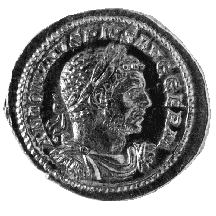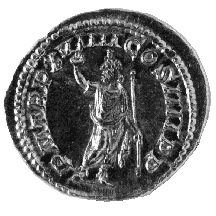



(114) Antoninus ("Caracalla") - AV aureus, A.D. 215,
6.55 g. (inv. 91.201).
Obverse: Laureate, draped, and cuirassed bust of Antoninus r.; ANTONINVS
PIVS AVG(VSTVS) GERM(ANICVS): Antoninus Pius Augustus, conqueror of the
Germans.
Reverse: Serapis standing l. wearing modius, scepter in l., r. raised.;
P(ONTIFEX) M(AXIMVS) TR(IBVNICIA) P(OTESTATE) XVIIII CO(N)S(VL) IIII P(ATER)
P(ATRIAE): Pontifex maximus, with tribunician power for the nineteenth
time, consul for the fourth time, father of the country.
Provenance: Bank Leu, 1974.
Bibliography: H. Mattingly and E.A. Sydenham, The Roman Imperial Coinage
IV.1: Pertinax to Geta (London 1936) 280.
Caracalla, so nicknamed by his troops for the Gallic cloak or caracallus
that he wore, was born Julius Bassianus to Septimius Severus and Julia Domna
in A.D. 188. When his father claimed adoption by Marcus Aurelius in A.D.
195, he changed his son's name to Marcus Aurelius Antoninus, which remained
his official name. He was made Caesar in A.D. 196 and Augustus in A.D. 198,
the latter elevation coinciding with Severus' great victory over the Parthians
(see no. 111). He ruled jointly with Severus until his death in A.D. 211
and then jointly with his brother, Geta, until he had him murdered in A.D.
212. He fought a series of campaigns on the German frontier, where he acquired
his nickname and took the title Germanicus, and in the East, where he aspired
to be the new Alexander. The greatest monument to his reign are the opulent
Baths of Caracalla in Rome, dedicated in A.D. 216. Caracalla was popular
with his troops, but his mental instability, his cruelty, and his hatred
of the Senate resulted in a conspiracy, and he was murdered in A.D. 217.
Caracalla rejected the philosopher-like portraiture of the Antonines for
the look of a military man. He is shown with short hair and a close-cropped
beard, and in his later portraits a V-shaped furrow in his brow produces
a scowl that reflects his cruel and violent nature. The type would serve
as a model for the portraits of the soldier-emperors of the third century.
Caracalla's father, Severus, had identified himself with the Egyptian god
Serapis, probably primarily for his African associations, and Caracalla
continued to honor his cult. His usual attribute is the modius, the
Roman grain measure, which he wears as a headdress symbolizing his connections
with fertility.
R.E.B.



All contents copyright (c) 1996.
Lawrence University
All rights reserved.